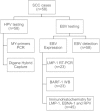Human papillomavirus and Epstein-Barr virus co-infection in cervical carcinoma in Algerian women
- PMID: 24252325
- PMCID: PMC4225508
- DOI: 10.1186/1743-422X-10-340
Human papillomavirus and Epstein-Barr virus co-infection in cervical carcinoma in Algerian women
Abstract
Background: Despite the fact that the implication of human papillomavirus (HPV) in the carcinogenesis and prognosis of cervical cancer is well established, the impact of a co-infection with high risk HPV (HR-HPV) and Epstein-Barr virus (EBV) is still not fully understood.
Methods: Fifty eight randomly selected cases of squamous cell carcinomas (SCC) of the uterine cervix, 14 normal cervices specimens, 21 CIN-2/3 and 16 CIN-1 cases were examined for EBV and HPV infections. Detection of HR-HPV specific sequences was carried out by PCR amplification using consensus primers of Manos and by Digene Hybrid Capture. The presence of EBV was revealed by amplifying a 660 bp specific EBV sequence of BALF1. mRNA expression of LMP-1 in one hand and protein levels of BARF-1, LMP-1 and EBNA-1 in the other hand were assessed by RT-PCR and immunoblotting and/or immunohischemistry respectively.
Results: HR-HPV infection was found in patients with SCC (88%), low-grade (75%) and high grade (95%) lesions compared to only 14% of normal cervix cases. However, 69%, 12.5%, 38.1%, and 14% of SCC, CIN-1, CIN-2/3 and normal cervix tissues, respectively, were EBV infected. The highest co-infection (HR-HPV and EBV) was found in squamous cell carcinoma cases (67%). The latter cases showed 27% and 29% expression of EBV BARF-1 and LMP-1 oncogenes respectively.
Conclusion: The high rate of HR-HPV and EBV co-infection in SCC suggests that EBV infection is incriminated in cervical cancer progression. This could be taken into account as bad prognosis in this type of cancer. However, the mode of action in dual infection in cervical oncogenesis needs further investigation.
Figures






References
-
- Anderson L, O’Rorke M, Jamison J, Wilson R, Gavin A. HPV Working Group members. Prevalence of human papillomavirus in women attending cervical screening in the UK and Ireland: new data from Northern Ireland and a systematic review and meta-analysis. J Med Virol. 2013;85:295–308. doi: 10.1002/jmv.23459. - DOI - PubMed
-
- Nichols W, Sutton K, Nelson N, Clark A, Oddo H, Love N, Hagensee M. (Abstract) 27th International Papillomavirus Conference, Clinical Workshop. Berlin, Germany; 2011. Epstein-Barr virus as a Potential Biomarker for Cervical Dysplasia; pp. 14–15. (Abstract book 2, page 59). http://www.hpv2011.org/index1.asp?siteid=1&pageid=63.
-
- Ekalaksananan T, Aromseree S, Pientong C, Sunthamala N, Swangphon P, Chaiwongkot A, Kongyingyoes B, Patarapadungkit N, Chumworathayee B. 27th International Papillomavirus Conference and Clinical Workshop. Berlin, Germany; 2011. (Abstract), Co-infection of Epstein-Barr Virus (EBV) with High Risk Human Papillomavirus (HR-HPV) is a Significant Risk of Cervical Cancer; pp. 14–33. (Abstract book 2, page 68). http://www.hpv2011.org/index1.asp?siteid=1&pageid=63.
-
- Silver MI, Paul P, Sowjanya P, Ramakrishna G, Vedantham H, Kalpana B, Shah KV, Gravitt PE. Shedding of Epstein-Barr virus and cytomegalovirus from the genital tract of women in a periurban community in Andhra Pradesh, India. J Clin Microbiol. 2011;49:2435–2439. doi: 10.1128/JCM.02206-10. - DOI - PMC - PubMed
Publication types
MeSH terms
Substances
LinkOut - more resources
Full Text Sources
Other Literature Sources
Medical
Research Materials

